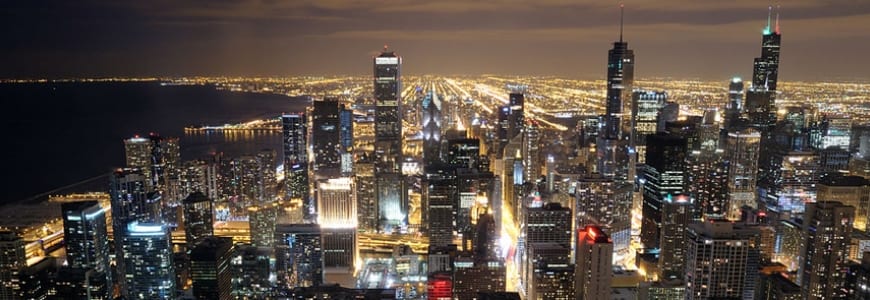By Rob Mitchum // February 12, 2015
Chicago is known as a city of skyscrapers, with some of the world’s tallest and largest buildings dotting the famous skyline. But all that square footage carries a hefty energy price tag, as well as significant opportunities for improved efficiency and savings. To encourage building owners to assess and reduce their energy usage, the City of Chicago passed the Building Energy Use Benchmarking Ordinance in 2013, requiring certain properties to report energy data.
Late last year, that effort produced the first Building Energy Benchmarking Report, containing insight and visualizations produced in part with the CI’s Urban Center for Computation and Data (UrbanCCD). The city’s Office of Sustainability approached UrbanCCD for help with analyzing data from 348 buildings larger than 250,000 square feet, the first round of energy benchmarking conducted under the ordinance. And on this first report card, the city fared well — demonstrating energy efficiency on par with buildings from other major cities, though with significant room for improvement that could save millions and reduce carbon emissions substantially.
“Energy benchmarking engaged the real estate and energy communities to increase transparency of building energy use and has uncovered tens of millions of dollars in potential savings,” said Chicago Mayor Rahm Emanuel. “Delivering those savings will increase competitiveness as we work toward a brighter economic and environmental future for our city.”
Benchmarking assesses a building’s energy performance and compares it with similar buildings, identifying places where efficiency can be improved to lower energy costs and environmental impact. Services such as ENERGY STAR and LEED use the types of data measured by benchmarking to determine a property’s energy performance, assigning a score or certification that may make a building eligible for certain tax benefits. While many buildings already collected and monitored such data, Chicago’s ordinance required reporting that information to the city, using a staged rollout that initially applied to only the largest buildings.
In the first wave of reporting, commercial buildings, schools, universities, medical facilities, and other properties (such as museums and park structures) submitted their energy usage. While this initial tally included only 348 of the approximately 50,000 buildings in Chicago, it covered over 10 percent of the city’s energy consumption. The report found that some sectors did better than others — commercial buildings were typically already above-average in their energy footprint, while schools, universities, and hospital buildings demonstrated a wider variance.
According to the report, the findings reveal opportunities for as much as $77 million in energy savings, should lower-rated buildings make changes to raise their energy efficiency to “above average.” Those improvements would also reduce the city’s carbon emissions by up to 844,000 tons, equivalent to eliminating 175,000 cars.
UrbanCCD analysts Matt Gee, Yujiang Mou, Ralph Muehleisen, and Alessandro Panella (working with the Mayor’s Office and Elevate Energy) contributed “under the hood” analysis to the report, looking at correlations between building characteristics and energy use. Surprisingly, the team found that building age was not correlated with energy use — structures built in the early 20th century did not perform significantly different from buildings constructed in the last two decades. The team also ran multivariate analyses to look for interactions between building features, and looked at some features not included in the report, such as building continuity.
The 2014 report is only the first fruit of Chicago’s benchmarking ordinance. This June, commercial and municipal buildings between 50,000 and 250,000 square feet and residential buildings larger than 250,000 square feet will report their energy data for the first time, providing information about an even larger slice of the city. The ordinance also mandated the public release of all data one year after reporting, giving Chicago’s thriving open data community an opportunity to run their own analyses beginning this summer.
“As more buildings are required to report, the amount of collected data becomes more and more interesting, allowing anybody to peek into energy consumption and perform any type of analysis on Chicago’s energy use,” Panella said. “This is unprecedented, as utilities companies aren’t known to have released building-specific data, just aggregates of past data.”

